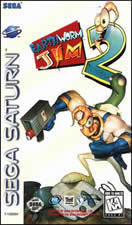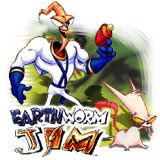Original video game characters rarely pop up and even when they do, they rarely attain popular heights (such as Mario, and Sonic, or even Bomberman). In 1994, Shiny Entertainment, a newly-founded company led by David Perry, created Earthworm Jim, which quickly became a landmark title in its own right because of its animation, quality, and originality. I know that for a fact that without Earthworm Jim, Shiny would NOT be around today (even if they only make questionable games now – Enter the Matrix anyone?). What came after the dawn of the 32-bit generation had nothing to do with the original team at Shiny and was pure and simple the result of licensing deals and merchandising. Because of this, the series was killed prematurely- or was it?
Developer History
 Douglas TenNaple came up with the game’s original concept, and he is credited for having created virtually all off the major characters, from Jim himself to “The evil Queen Pulsating, Bloated, Festering, Sweaty, Pus-filled, Malformed, Slug for a butt…….” (yes, that’s the real name). He also did Jim’s voice! Dave Perry himself was another key programmer for the the first two games, and he put together a crack team of artists, designers and programmers – some of which also came from his former employer, Virgin Interactive. Michael Koelsch drew the covers for both titles, as well as much of the media artwork. The now-classic soundtracks were scored by Tommy Tallarico, who has since gone on to work on literally dozens of games, most recently Advent Rising for the Xbox.
Douglas TenNaple came up with the game’s original concept, and he is credited for having created virtually all off the major characters, from Jim himself to “The evil Queen Pulsating, Bloated, Festering, Sweaty, Pus-filled, Malformed, Slug for a butt…….” (yes, that’s the real name). He also did Jim’s voice! Dave Perry himself was another key programmer for the the first two games, and he put together a crack team of artists, designers and programmers – some of which also came from his former employer, Virgin Interactive. Michael Koelsch drew the covers for both titles, as well as much of the media artwork. The now-classic soundtracks were scored by Tommy Tallarico, who has since gone on to work on literally dozens of games, most recently Advent Rising for the Xbox.
Founded in 1993, Shiny has become one of the top development companies in gaming, with several hits to their credit. One of its most recent title, Enter the Matrix, sold over six million copies worldwide, and they are set to continue the franchise with The Matrix: Path of Neo. In 2002, Shiny was acquired by Infogames in a deal worth 47 million dollars.
The Games
When David Perry started his new company Shiny Entertainment, he heard about Doug TenNapel from some friends. After being impressed by TenNapel’s work, he decided to not only hire him, but to make his demo into Shiny’s first project. The original Earthworm Jim made its debut in 1994 for many different formats, including the SNES, Sega Genesis, and Sega CD (Special Edition). It had two versions for the PC (one was a NEW Special Edition called Can o’ Worms), and even the Game Gear, and soon enough had many fans running through New Junk City and of course, Buttville. Word of mouth and some stellar reviews made it more popular than you’d ever believe, and it sold out almost everywhere. It surely wasn’t revolutionary (it was essentially a well put-together platformer), but it sure was damn fun to play. The off-the-wall humor and wacky objectives were fresh and simply hilarious, and the characters were highly likable. I recommend that regardless of which version you choose, you should definitely add this game to your collection.
The sequel was released in early 1995 for the Super Nintendo, Sega Genesis, Sega Saturn, and the PC. While it didn’t get as much fanfare as the first game and was arguably not as good, it was still great fun and expanded what was loved about the original. Being able to swim around as a blind salamander set to Beethoven was very cool, and it’s this sort of thing that made the series unique and garned it such a fan base. That’s why it appeared on so many platforms, and there was also even a Game Boy version of Earthworm Jim around this time.
 The Saturn version did nothing to take advantage of the new hardware, save for some improved animation and cleaner graphics. The game did benefit from a wonderful new CD soundtrack, which is worth listening to even when you’re not playing. While Earthworm Jim was a solid release for the Saturn, it marked the beginning of a three-year dormancy for the franchise, with only ports showing up on several different platforms. It would take almost five years for Jim to show up again in a new adventure.
The Saturn version did nothing to take advantage of the new hardware, save for some improved animation and cleaner graphics. The game did benefit from a wonderful new CD soundtrack, which is worth listening to even when you’re not playing. While Earthworm Jim was a solid release for the Saturn, it marked the beginning of a three-year dormancy for the franchise, with only ports showing up on several different platforms. It would take almost five years for Jim to show up again in a new adventure.
Of course, he was all over television and comic books by this time, thanks to lucrative deals with Warner Bros. and Marvel Comics, and it was only a matter of time before another sequel would be announced. Shiny was busy with other projects though, and the advent of 3D gaming was proving to be quite a test for established 2D platforming stars. Perry himself was branching out, taking a seat on the Game Developer’s Conference Advisory Board, and by starting a web site to help new talent enter the game industry.
In 1997, a Game Coy Color game was released by Crave Entertainment, called Earthworm Jim: Menace 2 the Galaxy. This is another one of those games in a series where people try to forget it exists (like EWJ 3D, and Zelda II). Based mostly on the T. V. show (info later), it featured Earthworm Jim at odds with Evil Jim, and was a generic platform game that had NOTHING to do with what the whole EWJ was about. You collected coin-like things, and strayed far from the series’ roots.
Years passed, and it looked like the famous invertabrate was finally ready for his first original outing of the new generation of consoles. Earthworm Jim 3D was set to be further the series’ plot (was there really one to begin with?). Be now however, almost all of the original EWJ team had moved to other projects and companies, and David Perry himself wanted to go on to different concepts and develop new games. Moreover, Doug TenNaple also had moved on from Shiny.
All these changes caused major turmoil in the game’s development. Interplay, who in 1995 bought Shiny and its licenses – along with Earthworm Jim, sold the publishing rights to the series in 1999. After much confusion over who was to finally publish it, VIS-PLC (which is now VIS Entertainment) stepped up to develop Earthworm Jim 3D. In the very early stages in development, Douglas TenNaple and Dave Perry expressed some interest in participating, but for no reason whatsoever, the development team dismissed their input and opinions. The game took MUCH, MUCH longer than it should have (it was even cancelled once!). For some reason, most of the development work was thrown out completely at one point, which caused even more confusion when it was released.
Most people who bought it took it back, as it had a buttload of glitches and bugs in it. The gameplay was terrible to top it off (and was worsened by possibly the most horrible camera ever implemented in a platformer). Most of the charm from the two previous installments had disappeared. Even the plot is as dry as can be. After getting hit in the head by a flying cow, Jim slips into a coma, and the player must travel through his mind to find all his “marbles.” Um…ok.
Earthworm Jim 3D also had toilet humor that was taken FAR too seriously, as “fart boosts” were as low as this series could go. VIS-PLC were relying on the selling potential of the license instead of putting their efforts into quality and gameplay, which is what the fans wanted. I mean, there were even levels that were cut out of the finished game that were on the box itself!
After stumbling in 3D, the series retreated to the safety of two dimensions. In early 2001 Earthworm Jim was released for the Game Boy Advance. It was published by Majesco and developed by Game Titan and was a port of the original game. The following year, Earthworm Jim 2 was released. Also a port, it was developed by Super Empire. Unfortunately, these ports played terribly, and lost most of their charm in the conversion process.
THE SOIL, HE DID CRAWL (it’s part of the TV show theme song)
When the first two EWJ games were released, it was obvious that Earthworm Jim was going to have to be in a TV show, and have plenty of merchandise. Even a comic book was inevitable at the time. Douglas TenNaple was the executive producer of the cartoon show (thank god), and he knew Doug Langdale – the show’s writer – as he had also been involved in the little-known show Project Geeker (another character Douglas invented). He was mentioned in the end credits, and they even made Jim give thanks to him in one of the shows.
Universal Cartoon Studios and Warner Bros. created a different style Earthworm Jim, compared to the original video games. Most of the humor was MUCH different (it was more political and ironic, and the characters were also much different in behavior and design). Jim was voiced by Dan Castellaneta (the voice of Homer Simpson). Originally, the voice of Jim was to be played by the actor Matt Frewer, but was changed instead for some reason. Jeff Bennett voiced Peter Puppy (now Jim’s sidekick) and the Narrator. Peter was MUCH different in design. Princess Whats-Her-Name (yes, that’s the real name) was voiced by Kath Soucie and was very feminist in every way possible. Evil the Cat became very smart, and had a new character “Henchrat” at his command. Designed for a specific audience, the series only lasted for 2 seasons (23 episodes in all). The network steered the show towards a young age group (much younger than it deserved), and it didn’t get the high ratings it needed. How young children would understand some of the jokes that had political undertones and irony I will never know, but it was still a great show to watch in its own right.
Along with the show came a toy line by Playmates (I had them all!). The designs were thankfully based off of the show’s character designs and were of somewhat high quality (except for Jim’s damn head, which is obviously too thin) Promotional extras showing the toys were also added to the Earthworm Jim: Can ‘o Worms game for the PC. Later, a three issue comic series was produced by Marvel Absurd in 1995. It did try to be more in tone with the game, as well as the show. It was a fun little series, and was not all that bad.
LOST IN THE DIRT?
 In 2002 Infogames (Now Atari) acquired Shiny Entertainment from Interplay, and at some later date Interplay and all the licences it had acquired became the property of Titus. No information about who owns the licence now is known. The last game that was made by the EWJ staff was Wild 9 for the Playstation, a high quality game (great fun, if I may add) that plays entirely different from EWJ, but retains the same charm and appeal (Tommy Tallarico did the music for this game as well!). I recommend it entirely, as it’s as cheap as Playstation games get, and even my local Rite Aid has it!
In 2002 Infogames (Now Atari) acquired Shiny Entertainment from Interplay, and at some later date Interplay and all the licences it had acquired became the property of Titus. No information about who owns the licence now is known. The last game that was made by the EWJ staff was Wild 9 for the Playstation, a high quality game (great fun, if I may add) that plays entirely different from EWJ, but retains the same charm and appeal (Tommy Tallarico did the music for this game as well!). I recommend it entirely, as it’s as cheap as Playstation games get, and even my local Rite Aid has it!
It is too bad that Earthworm Jim is nowhere to be found, as this was once a great franchise, but as it stands… I rather have the series left alone. I would love it, however, if it were to fall into the hands of Sega, Nintendo, or even Treasure (now THAT is wishful thinking), but I doubt anybody can get this series to really shine again, the way Shiny used to.
The complete release chronology is as follows:
- Earthworm Jim, Genesis (1994)
- Earthworm Jim, SNES (1994)
- Earthworm Jim 2, Genesis (1995)
- Earthworm Jim 2, SNES (1995)
- Earthworm Jim Special Edition, Sega CD (1995)
- Earthworm Jim special Edition, Game Boy (1995)
- Earthworm Jim, PC (1995)
- Earthworm Jim 1 & 2: The Whole Can ‘O Worms, PC (1996)
- Earthworm Jim, Game Boy Color (1997)
- Earthworm Jim 3D, N64 (1999)
- Earthworm Jim 3D, PC (2000)
- Earthworm Jim, Game Boy Advance (2001)
- Earthworm Jim 2, Game Boy Advance (2002)
Sources
- Developer History. Shiny.com.
- Garner, Katherine. Earthworm Jim History. NoMoreTangerines. 2005.
- Mielke, James. Earthworm Jim 3D review. Gamespot. November 16, 1999.

Recent Comments